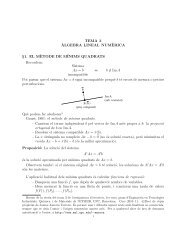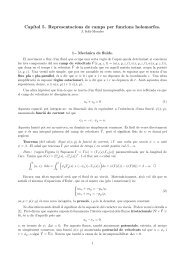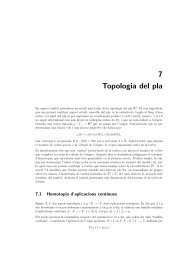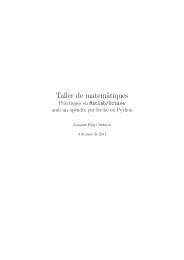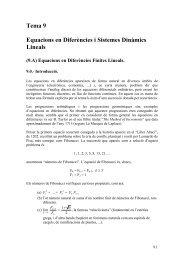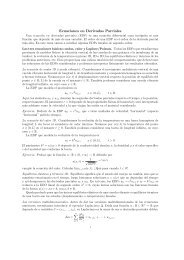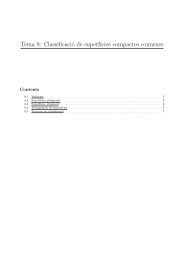Biomechanical Validation of Upper-body and Lower-body Joint - UPC
Biomechanical Validation of Upper-body and Lower-body Joint - UPC
Biomechanical Validation of Upper-body and Lower-body Joint - UPC
You also want an ePaper? Increase the reach of your titles
YUMPU automatically turns print PDFs into web optimized ePapers that Google loves.
Figure 5.<br />
3 Capture Description<br />
We want to record motions with optical motion<br />
capture <strong>and</strong> Kinect simultaneosly, <strong>and</strong> this leads<br />
to mount Kinect device inside the motion capture<br />
laboratory. As we can see in Figure 2,<br />
Kinect was mounted above a tripod placed in<br />
front <strong>of</strong> the actor. In case <strong>of</strong> the optical motion<br />
capture, it was normally set.<br />
Figure 2: Actor in motion capture laboratory<br />
with a Kinect mounted in front <strong>of</strong> him.<br />
To test Kinect accuracy, we have studied<br />
movements from upper <strong>body</strong> <strong>and</strong> lower <strong>body</strong><br />
following all <strong>body</strong> planes (Figure 3). So, we select<br />
three joints: shoulder, hip <strong>and</strong> knee. For<br />
the shoulder we have recorded movements in all<br />
planes <strong>of</strong> the <strong>body</strong>, in case <strong>of</strong> hip, sagital <strong>and</strong><br />
coronal rotations. To validate the movement <strong>of</strong><br />
the knee, flexion <strong>and</strong> extension movements were<br />
recorded.<br />
Recording motion with two independent<br />
systems requires some kind <strong>of</strong> synchronization<br />
when you start recording a movement. Additionally,<br />
each system needs some specific<br />
steps to be initialized. In case <strong>of</strong> Kinect, it<br />
is indispensable to calibrate user in order to<br />
get joint positions. So, at the beginning <strong>of</strong> the<br />
capture session, user was asked to be calibrated<br />
by Kinect system. From this point, Kinect was<br />
reporting tracking information. In the other<br />
Figure 3: Body planes.<br />
h<strong>and</strong>, optical motion capture workflow forces<br />
actor to start every clip in t-pose for later easy<br />
data cleaning. So, we manually activate both<br />
systems when actor was in t-pose. Each system<br />
capture motion <strong>and</strong> save it in a specific way<br />
that will be explained in depth in the following<br />
sections. Temporal synchronization between<br />
pairs <strong>of</strong> motions is obviously not very accurate.<br />
In Section 4 we will explain how we have fixed<br />
synchronization problem. Finally, we have<br />
obtained the amount <strong>of</strong> data described in Table<br />
1. We have recorded capture sessions in video<br />
too.<br />
<strong>Joint</strong> Plane <strong>of</strong> movement Frames<br />
Knee Relative to parent 5998<br />
Hip Sagittal 3152<br />
Hip Coronal 1893<br />
Shoulder Sagittal 4261<br />
Shoulder Coronal 3114<br />
Shoulder Traversal 2018<br />
Table 1: Recorded movements.<br />
3.1 Optical Motion Data<br />
As we have explained before, to capture motion<br />
using an optical system actor have to wear<br />
attached optical markers whose positions are<br />
reported. On the contrary, Kinect motion<br />
capture system reports joint positions. So,<br />
in order to compare them it is m<strong>and</strong>atory to<br />
adapt one representation to the other. We have



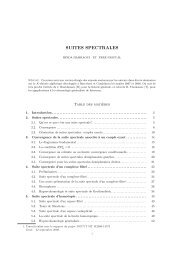
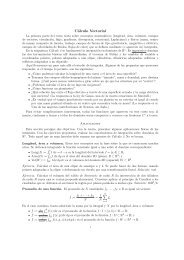
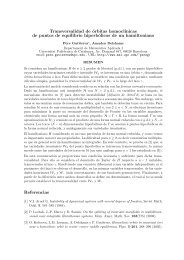
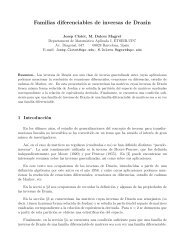
![INTEGRALES ELÍPTICAS COMPLETAS Dado un parámetro m ∈ [0,1]](https://img.yumpu.com/14067465/1/184x260/integrales-elipticas-completas-dado-un-parametro-m-01.jpg?quality=85)


